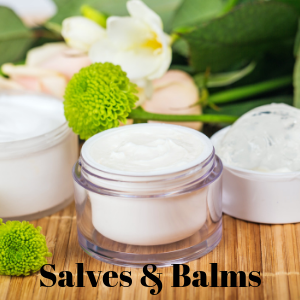The Ultimate Guide to Herbal Salves & Balms: Natural Healing for Your Skin
Soothe, Protect, and Nourish with Herbal-Infused Remedies
Herbal salves and balms are a powerful, all-natural way to heal and protect your skin. Whether you need a soothing balm for dry skin, a healing salve for cuts and wounds, or a muscle-relief rub, making your own herbal salves allows you to control the ingredients and maximize their benefits—without synthetic chemicals or preservatives.
In this guide, you’ll learn:
✔ The difference between herbal salves and balms
✔ Step-by-step instructions for making your own skin-healing remedies
✔ Best herbs for soothing, pain relief, and skin nourishment
✔ Tips for proper storage and application
Take your skincare into your own hands—start making herbal salves and balms today!

Herbal Balms & Salves – Natural Healing for Skin
How to Make an Herbal Salve or Balm: A Step-by-Step Guide
Herbal salves and balms are natural, effective ways to soothe, protect, and heal the skin. Whether you're making a moisturizing balm for dry skin, a healing salve for wounds, or a muscle-relief formula, this guide will walk you through the process of creating high-quality, long-lasting herbal salves and balms at home.
Step 1: Choose & Prepare Your Herbs
✅ Select organic, high-quality dried or fresh herbs for their therapeutic properties.
✅ Use ½ cup of dried herbs or 1 cup of fresh herbs per 1 cup of carrier oil.
✅ Mix multiple herbs for enhanced benefits.
Pro Tip: Best herbs for salves and balms:
- For Wound Healing: Calendula, Plantain, St. John’s Wort, Comfrey
- For Muscle & Joint Relief: Arnica, Cayenne, Ginger, Peppermint
- For Skin Nourishment & Hydration: Chamomile, Lavender, Rose, Aloe Vera
Step 2: Infuse Herbs into Carrier Oil
✅ Place herbs in a glass jar or double boiler.
✅ Cover with a carrier oil such as olive oil, coconut oil, almond oil, or jojoba oil.
✅ Infuse using one of these methods:
Slow Method: Seal the jar and let it sit in a warm, sunny place for 4-6 weeks, shaking daily.
- Fast Method: Heat the mixture on low heat (100-120°F) for 2-4 hours using a double boiler or slow cooker.
✅ Once infused, strain the oil through a fine-mesh sieve or cheesecloth.
Pro Tip: Do not overheat the oil, as excessive heat can destroy beneficial herbal compounds.
Step 3: Add Beeswax for Thickening
✅ Melt 1 ounce of beeswax per 1 cup of infused oil using a double boiler.
✅ Stir continuously until completely melted and well combined.
✅ If you prefer a softer balm, reduce beeswax; for a firmer salve, add more.
Pro Tip: Use Candelilla wax or Carnauba wax as a vegan alternative.
Step 4: Enhance with Essential Oils & Additives
✅ Add 10-20 drops of essential oils per 1 cup of salve for aroma and added benefits.
✅ Optional: Stir in Vitamin E oil (1 teaspoon per cup) to extend shelf life.
✅ Stir well to ensure even distribution.
Pro Tip: Best essential oils for balms & salves:
For Pain Relief: Eucalyptus, Peppermint, Wintergreen
For Skin Healing: Lavender, Tea Tree, Frankincense
For Relaxation: Chamomile, Rose, Sandalwood
Step 5: Pour & Store Properly
✅ Pour the mixture into sterilized glass jars or metal tins while still warm.
✅ Allow it to cool and solidify completely before sealing the containers.
✅ Store in a cool, dark place for up to 1 year.
Pro Tip: Label each container with:
Herb name(s) & botanical name(s)
Date of preparation
Usage instructions (e.g., "Apply to affected area as needed")
Any safety precautions (e.g., "For external use only")
Start today with high-quality herbs and create your perfect herbal balm or salve! Personally, I love making my own lip balm—it's fantastic, if I do say so myself!
Final Thoughts: The Joy of Creating Your Own Herbal Preparations
Making your own herbal preparations—whether it's a nourishing tea, a potent tincture, a healing balm, or a soothing syrup—is one of the most rewarding and empowering experiences in herbal medicine. Not only do you get to customize your remedies to fit your personal health needs, but you also gain complete control over the quality, purity, and effectiveness of what you’re using.
